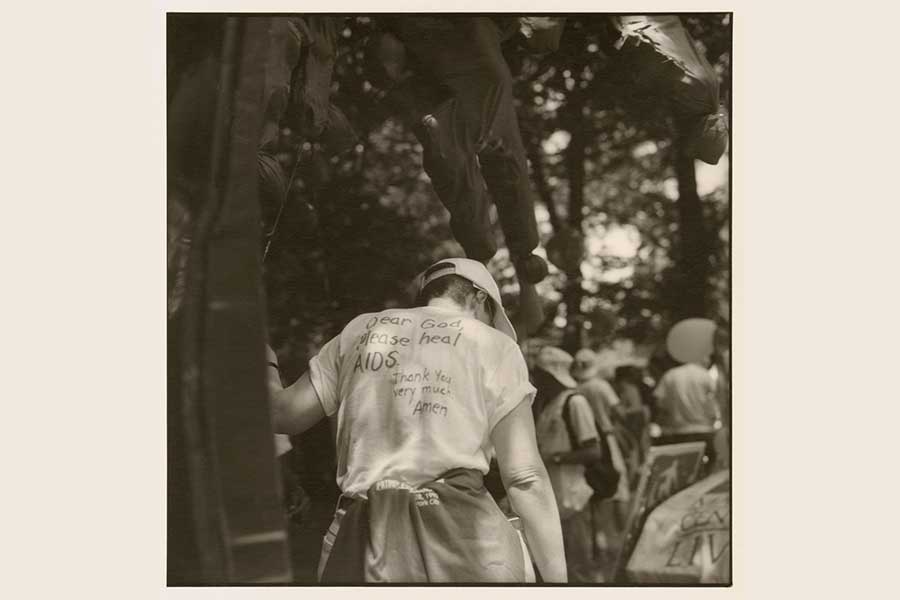The curious interplay between photographer and subject, light and shadow is evident in “Bruce Cratsley: Shifting Identities,” an eye-opening exhibit of more than 30 black-and-white photographs by a noteworthy gay artist currently on display in the List Gallery at Swarthmore College.
The exhibit, curated by List Gallery director Andrea Packard and Pulitzer Prize-winning photographer Ron Tarver, runs through Oct. 30. The show is open to the public; admission is free. A gallery talk about Cratsley’s work, “Moments in Light,” is scheduled for Oct. 19.
Cratsley, who died of complications from AIDS in 1998, was a prolific photographer active from the mid-1970s to the mid-1990s. In 1996, the Brooklyn Museum mounted an exhibit of his work.
When he reviewed that show for the New York Times, Holland Carter, an art critic, noted the dreamlike quality of Cratsley’s work. He went on to write, “Whether Mr. Cratsley is setting up a surreal play of glinting reflective surfaces or picking his subjects out from velvety, penumbral darkness like jewels on a cushion, the combination of elegance and evanescence that results is his signature.”
The current exhibit is a homecoming of sorts. Cratsley’s family moved to Swarthmore when he was a young boy. His father, Edward, was a senior administrator at Swarthmore College.
As an undergraduate at Swarthmore, Cratsley majored in art history and participated in student plays. After graduating in 1966, he moved to New York City and began to study photography with Lisette Model, an acclaimed modernist photographer who was a lifelong influence on his work. In addition to his photography, Cratsley was also a curator at the Marlborough Gallery.
According to Packard, a selection of Cratsley’s photographs was shown on campus when the List Gallery opened in 1991. While planning for the space’s 25th anniversary, she and her colleagues agreed that Cratsley’s work deserved renewed attention.
“Bruce’s vision embodies the kind of values that Swarthmore College holds dear: engagement with beauty and the world; exploration of the paradoxes of human perception and experience; and a concern for others,” Packard said.
The current exhibit offers a representative sample of Cratsley’s wide-ranging vision. It includes still-lifes, street scenes and portraits. Some of the photographs are carefully composed images; others are impromptu snapshots of urban life.
Whether Cratsley was photographing statues, as in “French Legs,” or sunbathers in “Beach, Atlantic City,” certain elements characterize his work. Packard praised his breadth of detail, his beautiful palette of tones and his expert framing. “Those formal complexities draw us to his subject and keep us engaged,” she said.
There is also an undercurrent of mystery running throughout Cratsley’s work. The photograph “Charlie Descending,” for example, has an off-kilter, downward perspective. And its subject, a young boy, is slightly out of focus. What’s going on isn’t clear, and that is deliberate.
“A lot of his work expresses that sense of identities being fluid and uncertainties being troubling,” Packard said. “There’s a hint of danger, but there’s also a sense that he revels in this kind of fluidity, where identities begin and end.”
Cratsley’s photographs of gay and lesbian life will be of particular interest to PGN readers. For years, he photographed Manhattan’s Gay Pride events as well as Wigstock, a drag festival in the East Village. Some images, like the untitled photo referred to as “costumed man,” are joyful and proud. Others, including “Dear God Please Heal AIDS,” are heartbreaking.
Perhaps the most moving images on display are the intimate portraits Cratsley took of his partners, all of whom succumbed to AIDS. They include “Indian Head Avenue,” a pensive photo in which light and shadow fall across his lover’s bare chest.
Even in these intensely personal photographs, Cratsley’s distinctive sensibility expresses itself. In “Wings of Light,” for example, viewers see a person, shot from behind, leaning over on a bed. Exactly who it is and what the gesture means is unclear. The bedroom is shrouded in darkness, but the subject’s shoulder blades are illuminated by light, giving the impression of an angel’s wings.
For Packard, this photograph is mysterious and tender. “That use of light and dark creates this image of both surrender and transcendence at the same time, for me. It seems like an image of someone who might be suffering and ascendant, who’s human but transfigured at the same time,” she said.
Cratsley’s work is also noteworthy because it hearkens back to a time before digital photography was ubiquitous. Packard described him as a master printer, and emphasized his work’s tactile quality and warm tones.
“There’s a quality to these images that you cannot get digitally and that you can’t appreciate digitally,” she said. “You have to see it in person the way you would a painting.”
For more information about “Bruce Cratsley: Shifting Identities,” visit http://www.swarthmore.edu/list-gallery/bruce-cratsley-shifting-identities.

